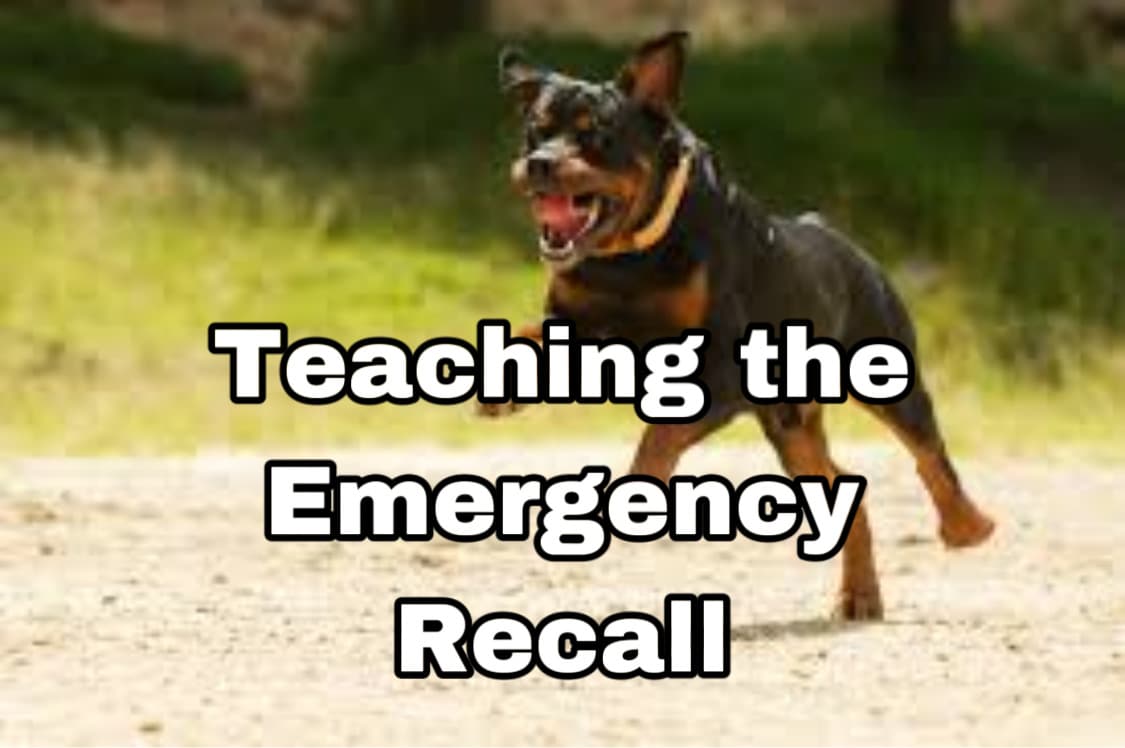dog training, Dog Training and Behavior, Emergency Recall, Pet Safety, Uncategorized
How to Teach a Dog The Emergency Recall
The Importance and Mastery of the Emergency Recall for Dogs
(Please be Sure to Listen to the Dog Training Podcast on Teaching The Emergency Recall at the End of this Article.)For many pet parents, the thought of their beloved canine companion darting off in an unpredictable environment can evoke sheer panic. Whether chasing after a squirrel, becoming overly excited by a passerby, or reacting to sudden noises, these unpredictable moments underscore the importance of an emergency recall. Unlike the standard recall that might be used in day-to-day situations, the emergency recall is designed for situations when safety is the absolute priority. In today’s guide, we will explore the step-by-step process of teaching and mastering the emergency recall, ensuring that our furry friends are always within a safe shout away.
What is the Emergency Recall?
The emergency recall is a command or cue that prompts a dog to return to its pet guardian immediately. This recall is distinct from the regular recall used in casual situations, and its primary function is safety. It is the ‘break glass in case of emergency’ recall, which, when executed correctly, can prevent accidents and potential dangers.
Teaching The Emergency Recall: A Comprehensive Guide
Pre-requisites for Effective Training:
- Location: Begin in a distraction-free indoor setting.
- Training Treats: Select treats that your dog cannot resist.
- Leash: Start with a 6-foot standard leash, eventually transitioning to a longer line for distance practice.
- Clicker: A valuable tool for marking desired behaviors (requires prior conditioning).
Phase 1: Laying the Foundations Before diving deep into recall training, we need to lay a foundation. This phase revolves around making your dog understand and associate the recall cue with delightful rewards.
Steps to Introduce the Emergency Cue:
- Choose a Distinct Cue Word: Words like “Emergency” or “Now!” are effective.
- Build the Association: After vocalizing the cue word, immediately present the treat. Repeat this sequence several times, ensuring the dog starts connecting the cue with the treat.
Phase 2: Introducing the Element of Distance Once the foundation is set, it’s time to add a dash of complexity. Introduce a small distance between you and your dog, making the recall slightly more challenging but still manageable.
Steps to Enhance Distance Awareness:
- Initiate the Distance: With the leash on, create a gap of 2-3 feet between you and your dog.
- Utilize the Cue: Upon using the emergency cue, watch as your dog approaches you. Remember, the leash is only a safety measure, not a means to force your dog.
Phase 3: Upping the Ante with Distractions With distance introduced, the next challenge is distractions. Whether it’s another pet or an enticing toy, distractions can test the strength of your recall command.
Steps to Counter Distractions:
- Introduce Distractions Gradually: Start with minor distractions, progressively making them more challenging.
- Utilize the Recall Cue: Even with distractions, your dog should respond to the emergency recall. Praise and reward them for their focus.
Phase 4: Real-World Implementation It’s time to take the training wheels off and test the recall in more diverse settings. From parks to busy streets, this phase is all about real-world readiness.
Steps for Real-World Practice:
- Safe Locations First: Start with environments that are safe but have enough distractions.
- Consistent Practice: The key lies in repetition. The more diverse situations your dog experiences, the better their recall will become.
Phase 5: The Art of Maintenance Even after mastering the recall, periodic reviews are necessary. This phase ensures that the emergency recall remains a robust tool in your arsenal.
Steps for Ongoing Refinement:
- Periodic Reviews: Practice the recall in diverse settings, ensuring it remains effective.
- Reward, Reward, Reward: Reinforce the recall’s value with continuous rewards.
Advanced Techniques for the Avid Trainer For pet parents aiming to go above and beyond, several advanced techniques can enhance the emergency recall:
- Jackpot Rewarding: Surprise your dog with an extraordinary treat or extended playtime, especially if their recall is swift.
- Premack Principle: Use the dog’s favorite activities as a reward for their obedience.
- Life Rewards: Beyond treats, real-world rewards like a walk or greeting another dog can be effective.
- Proofing: Test the recall in unpredictable environments to ensure it remains reliable.
Troubleshooting Common Hurdles Training isn’t always smooth sailing. Here are some common challenges and solutions:
- Unresponsive Dog: Return to Phase 1 if your dog isn’t associating the cue with rewards.
- Slow Recalls: Enhance the value of your rewards or introduce playful elements.
- Distracted Dog: Reduce the environment’s complexity and introduce distractions gradually.
- Zooming Past: Introduce secondary behaviors like “sit” upon recall to address this.
- Poisoning The Cue: The emergency recall cue should remain positive. Never associate it with unfavorable experiences.
In Conclusion The Emergency Recall is more than just a command – it’s a lifeline. As pet guardians, ensuring the safety of our canine companions is paramount. By dedicating time to mastering this recall, we forge a bond of trust with our dogs, assuring them that we are always their safe harbor, no matter the situation.
Remember, patience, consistency, and positive reinforcement are the pillars of effective training. With time, effort, and love, your dog will not only understand the emergency recall but will also look forward to responding to it with enthusiasm.
References
- Lindsay, S. R. (2001). Handbook of applied dog behavior and training, Vol 2.
- Reid, P. (1996). Excel-erated Learning.
- Zak (2017). Dog Training Revolution.
- McConnell, Patricia B., and Karen B. London. “The other end of the leash.”
- Premack, David. “Reinforcement theory” in Nebraska Symposium on Motivation, 1965.
- McDevitt, Leslie. “Control Unleashed.”
- Donaldson, Jean. “The Culture Clash.”
- Fisher, J. (1999). “Think Dog: An Owner’s Guide to Canine Psychology”.


